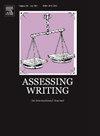The impact of self-revision, machine translation, and ChatGPT on L2 writing: Raters’ assessments, linguistic complexity, and error correction
IF 5.5
1区 文学
Q1 EDUCATION & EDUCATIONAL RESEARCH
引用次数: 0
Abstract
This study explores how learners in a South Korean high school English as a Foreign Language (EFL) context can effectively use neural machine translation (MT) and ChatGPT to enhance their L2 writing. While recent AI tools offer significant potential for supporting human writing feedback, a comparative analysis of how these tools impact writing outcomes—compared to when L2 writers independently proofread and revise their writing—has not been fully examined. To address this gap, a controlled experiment was conducted using three distinct proofreading interventions—self-proofreading (SP), MT-assisted proofreading (MAP), and ChatGPT-assisted proofreading (CAP). Learners were encouraged to first compose their texts in their L2 and then use either MT through inverse translation or ChatGPT through a structured proofreading process. The findings revealed that learners using MAP and CAP demonstrated substantial improvements in overall writing quality compared to those relying solely on SP. CAP users, in particular, produced longer texts, exhibited greater lexical diversity, and constructed more complex sentences, although this was accompanied by reduced verb cohesion. Both MAP and CAP significantly reduced grammatical errors, but did not affect prepositional errors. These findings provide practical recommendations for integrating MT and ChatGPT into L2 writing pedagogy.
自我修改、机器翻译和聊天翻译对第二语言写作的影响:评分者的评估、语言复杂性和错误纠正
本研究探讨了韩国高中英语学习者如何有效地使用神经机器翻译(MT)和聊天翻译(ChatGPT)来提高他们的第二语言写作。虽然最近的人工智能工具在支持人类写作反馈方面提供了巨大的潜力,但对这些工具如何影响写作结果的比较分析(与第二语言作者独立校对和修改写作时相比)还没有得到充分的研究。为了解决这一差距,我们进行了一项对照实验,使用了三种不同的校对干预措施——自我校对(SP)、mt辅助校对(MAP)和chatgpt辅助校对(CAP)。我们鼓励学习者首先用第二语言编写文本,然后通过逆向翻译或结构化校对过程使用MT或ChatGPT。研究结果显示,使用MAP和CAP的学习者与只使用SP的学习者相比,在整体写作质量上有了实质性的提高。特别是使用CAP的学习者,他们写出了更长的文本,表现出更大的词汇多样性,并构建了更复杂的句子,尽管这伴随着动词衔接的降低。MAP和CAP都能显著减少语法错误,但对介词错误没有影响。这些发现为将MT和ChatGPT整合到第二语言写作教学中提供了实用的建议。
本文章由计算机程序翻译,如有差异,请以英文原文为准。
求助全文
约1分钟内获得全文
求助全文
来源期刊

Assessing Writing
Multiple-
CiteScore
6.00
自引率
17.90%
发文量
67
期刊介绍:
Assessing Writing is a refereed international journal providing a forum for ideas, research and practice on the assessment of written language. Assessing Writing publishes articles, book reviews, conference reports, and academic exchanges concerning writing assessments of all kinds, including traditional (direct and standardised forms of) testing of writing, alternative performance assessments (such as portfolios), workplace sampling and classroom assessment. The journal focuses on all stages of the writing assessment process, including needs evaluation, assessment creation, implementation, and validation, and test development.
 求助内容:
求助内容: 应助结果提醒方式:
应助结果提醒方式:


